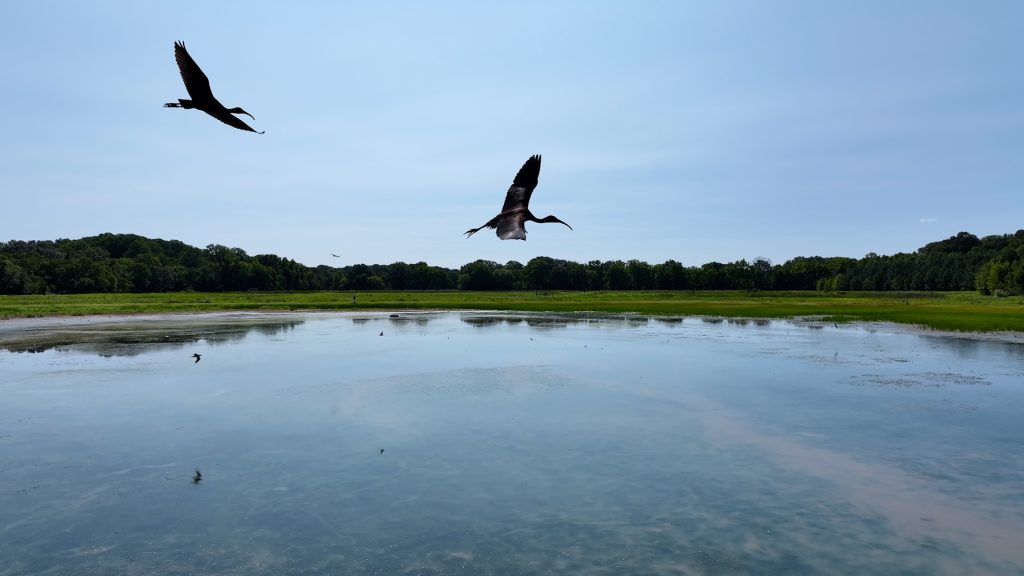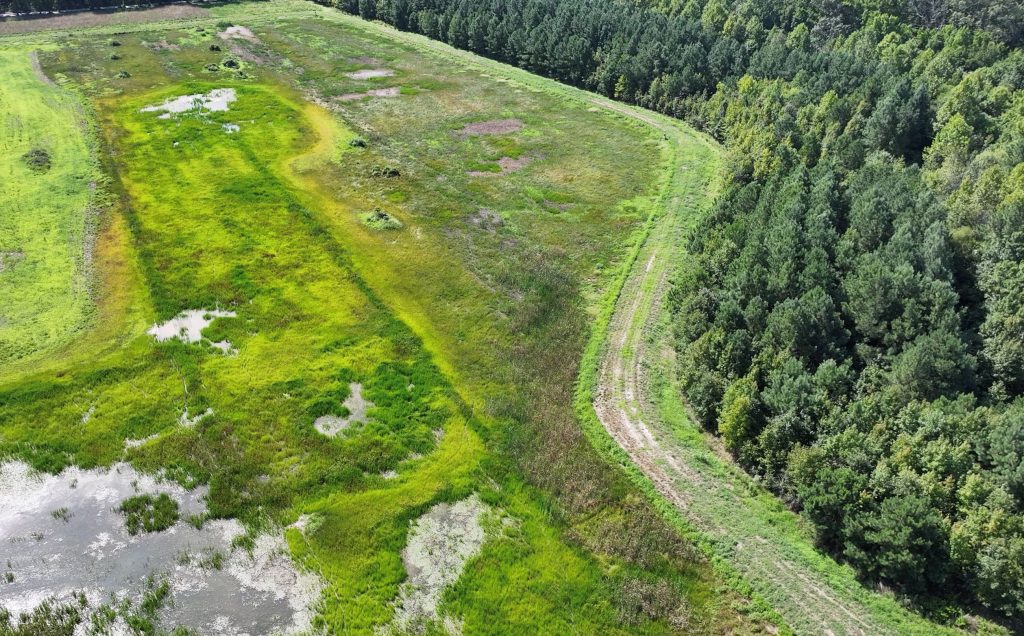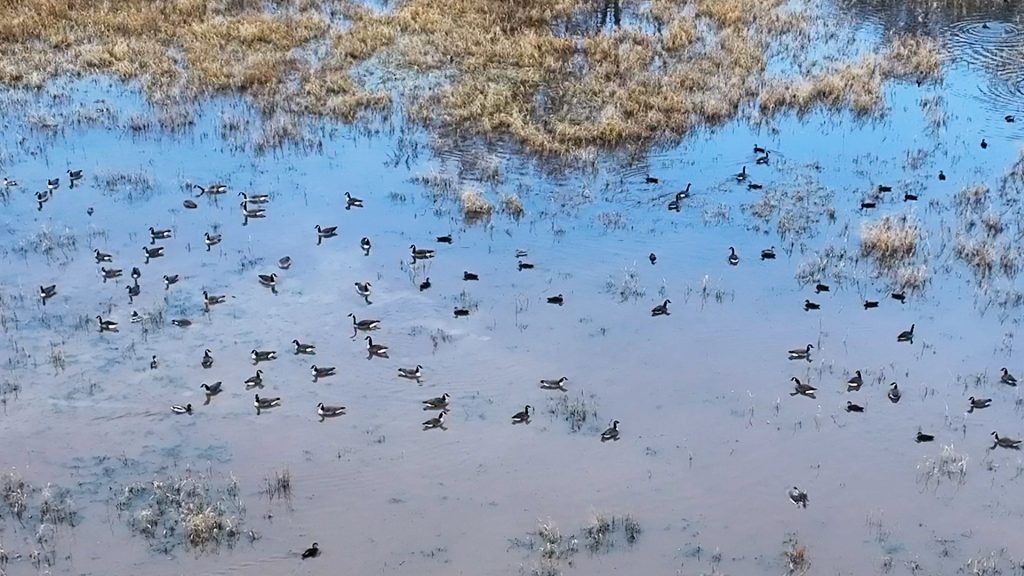Restored Wetlands at Wye Island Provide Bustling Habitat for Waterbirds
Site on Eastern Shore supports recreation and acts as “big green sponge” filtering water

Glossy ibises and other waterbirds fly above a restored wetlands on Wye Island Natural Resource Management Area. Photo by Winn Brewer, Maryland DNR
A few years ago, the land around the Holly Tree Trail on Wye Island was all agricultural fields.
But now, just a few steps into the trail, visitors can hear the quacks and clamor of hundreds or sometimes thousands of ducks and geese. During the winter migration, several wetlands attract sandpipers, greater yellowlegs, killdeer, glossy ibis, and many other waterbirds.
Wye Island Natural Resource Management Area, not far from the Chesapeake Bay Bridge in Queen Anne’s County on the Eastern Shore, is home to restored wetlands that support a thriving community of birds, in addition to benefiting Chesapeake Bay water quality and providing a recreation space for people to encounter wildlife.
The Maryland Department of Natural Resources, the conservation nonprofit Ducks Unlimited, and other partners have restored nearly 50 acres of wetlands on several sites on Wye Island over the past 30 years. The island had been predominantly used for agriculture since the colonial era, when farms in the area produced tobacco and wheat, and today Wye Island Natural Resource Management Area is a popular destination for hunting and birdwatching.
The most recent work, completed in 2021, converted agricultural fields into 23 acres of emergent wetlands and another 2.5 acres of wetland buffer areas. The project was funded by $113,056 from the department’s Chesapeake and Atlantic Coastal Bays Trust Fund and a $90,424 investment from Ducks Unlimited. Ducks Unlimited coordinated with several units of the department—Chesapeake and Coastal Service, Maryland Park Service and Wildlife and Heritage—to plan and design the project.
This restoration built upon similar projects at four sites totaling another 25 acres of wetland restorations that have occurred on Wye Island since the 1990s.
“We’re taking out these fields that have been a struggle to cultivate for decades and are only getting less farmable with our changing storm cycles and putting them back to what Mother Nature wants them to be,” said Sarah Hilderbrand, a DNR senior restoration specialist.

An aerial view of part of the wetlands restoration project completed in 2021. Photo by Winn Brewer/DNR
DNR game bird biologists helped spur on the latest project when they noticed that the natural resource management area had more land that could be converted to productive wetlands. Other DNR units and Ducks Unlimited were quickly on board with the effort.
“We went from the idea, to funding the design and the construction, to completion within 12 months,” said Josh Homyack, the department’s game bird section leader. “That doesn’t happen unless you have a lot of buy-in from all the partners.”
In order to build these wetlands, the department and its partners brought in subcontractors to dig out areas of land that would become impoundment ponds, using the dug-up earth to create berms, or raised embankments, along the edges. A water control system allows the department to retain water in the ponds, release water to a certain level, or bring in additional water.
Wildlife quickly responded. Hilderbrand said frogs were “everywhere” within weeks of constructing the pond.
Birds also arrived quickly. The Chesapeake Bay is part of the Atlantic Flyway—a major migration corridor for birds on the East Coast—and the Bay welcomes nearly a million birds each winter.
On their southern migration, birds are on the lookout for areas where they can rest and forage for food. Wetlands, like those at Wye Island, provide shelter as well as a copious source of seeds, invertebrates, and aquatic plants to feed on. Healthy birds with access to diverse food sources also maintain strong immune systems. Providing and maintaining high-quality habitat is one way to help wild birds stay strong and resistant to diseases, Homyack said.
While the site attracts black ducks, mallards, Canada geese, northern shovelers, pintails and more waterbirds and shorebirds, it also provides a habitat for other wildlife. On a late fall visit, DNR staff encountered deer grazing near the wetlands, a northern harrier patrolling from the skies, and an American woodcock fluttering out of a clearing in the woods.
The benefits of the restored wetlands at Wye Island extend far beyond the birds and wildlife, Scott Reinhart, a regional biologist with Ducks Unlimited, said. He described the restored wetlands as a “big green sponge” that filters water before it reaches the Chesapeake Bay.
“As surface water comes in or rain events take place, these wetlands and these soils swell, and they retain that water and they’ll let it out or it’ll infiltrate through the soils slowly,” Reinhart said. “The diversified vegetation communities in these wetlands, they each play a significant role in filtering the sediments, the nutrients, nitrogen and phosphorus.”
Ducks Unlimited supports wetland restorations and other conservation projects throughout the U.S. and internationally. DNR has numerous other wetland restoration projects, including a site at Tuckahoe State Park, where the department has also partnered with Ducks Unlimited.

Canada geese and several ducks make use of another impoundment pond at an earlier wetland restoration on Wye Island. Photo by Winn Brewer, Maryland DNR
At a visit to the Wye Island wetlands, DNR Secretary Josh Kurtz said the site was an example of how partnerships can support places that help wildlife and water quality, while also supporting scientific work and opportunities for recreation.
“We really appreciate this collaborative effort,” Kurtz said. “The fact that Ducks Unlimited is bringing engineers, scientists, and public outreach to help us build waterfowl habitat and improve Chesapeake Bay water quality really shows the power of our partnership.”
Habitat projects like the Wye Island wetland restoration tend to benefit a lot of other things too, Homyack said. Every bit helps when it comes to improving water quality in the Bay, and Wye Island’s size and location make it especially effective. These restored wetlands at Wye Island Natural Resources Management Area are permanently conserved land that is close to both active agricultural fields and the Chesapeake, allowing for water quality benefits in an area that’s also ecologically important.
“We can have a huge impact by doing things at the right spot in the landscape to get the most bang for your buck to improve water quality and mitigate all those other things that we’re doing,” Homyack said. “That’s why projects of this size, located on a place like the Wye, are a big deal.”
By Joe Zimmermann, science writer with the Maryland Department of Natural Resources
